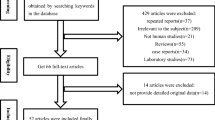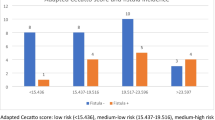Abstract
Pharyngocutaneous fistula (PCF) is the most common complication which significantly increases morbidity. High-level evidence is lacking that determines the PCF rates in the primary laryngectomy. The main objective of this study was to systematically identify the factors leading to the PCF formation in primary laryngectomy. Human studies reporting at least one risk factor for developing PCF in patients undergoing primary total laryngectomy for laryngeal cancer were included. PubMed, EMBASE, and Cochrane databases were searched for the data extraction. Risk of bias assessment tool for non-randomized trial tool was used. Cochrane’s Q test and Higgin’s I2-heterogeneity was applied. The Mantel–Haenszel and DerSimonian Laird method was employed. Odds ratio was calculated for each risk factor, a P-value < 0.05 was considered as statistically significant. PROSPERO registration CRD42021248382. The meta-analysis comprised a total of 2446 patients in 14 included non-randomized studies. The among the analyzed risk factors—comorbidities (OR 2.781, R: 1.892–4.088, P < 0.001), site of tumor (OR 4.485, R: 3.003–6.699, P < 0.001), low pre-operative hemoglobin (OR 3.590, R: 2.130–6.050, P < 0.001), low pre-operative albumin (OR 2.833, R: 1.596–5.031, P < 0.001), utilization of surgical staplers (OR 0.172, R: 0.064–0.460, P < 0.001) (protective effect), positive mucosal margin (OR 4.92 R: 1.90–12.75, P = 0.001). The risk factors for PCF in patients undergoing primary TL included comorbidities, hypopharyngeal involvement, pre-operative hemoglobin and albumin, stapler usage, and positive mucosal margin.
Level of Evidence - III






Similar content being viewed by others
Data Availability
Data is available with the corresponding author.
References
Bobdey S, Jain A, Balasubramanium G (2015) Epidemiological review of laryngeal cancer: an Indian perspective. Indian J Med Paediatr Oncol Off J Indian Soc Med Paediatr Oncol 36(3):154–160
Ahn S-H, Hong HJ, Kwon SY, Kwon KH, Roh J-L, Ryu J et al (2017) Guidelines for the surgical management of laryngeal cancer: Korean Society of Thyroid-Head and Neck Surgery. Clin Exp Otorhinolaryngol 10(1):1–43
Molteni G, Sacchetto A, Sacchetto L, Marchioni D (2020) <p>Optimal management of post-laryngectomy pharyngo-cutaneous fistula</p>. Open Access Surg 13:11–25
Shea BJ, Reeves BC, Wells G, Thuku M, Hamel C, Moran J et al (2017) AMSTAR 2: a critical appraisal tool for systematic reviews that include randomised or non-randomised studies of healthcare interventions, or both. BMJ 358:j4008
Bramer WM, Rethlefsen ML, Kleijnen J, Franco OH (2017) Optimal database combinations for literature searches in systematic reviews: a prospective exploratory study. Syst Rev 6(1):245
Page MJ, McKenzie JE, Bossuyt PM, Boutron I, Hoffmann TC, Mulrow CD et al (2021) The PRISMA 2020 statement: an updated guideline for reporting systematic reviews. Int J Surg 88:105906
Thompson CSG, Asimakopoulos P, Evans A, Vernham G, Hay AJ, Nixon IJ (2020) Complications and predisposing factors from a decade of total laryngectomy. J Laryngol Otol 134(3):256–262
Wakisaka N, Murono S, Kondo S, Furukawa M, Yoshizaki T (2008) Post-operative pharyngocutaneous fistula after laryngectomy. Auris Nasus Larynx 35(2):203–208
Markou KD, Vlachtsis KC, Nikolaou AC, Petridis DG, Kouloulas AI, Daniilidis IC (2004) Incidence and predisposing factors of pharyngocutaneous fistula formation after total laryngectomy. Is there a relationship with tumor recurrence? Eur Arch Oto-Rhino-Laryngol Off J Eur Fed Oto-Rhino-Laryngol Soc EUFOS Affil Ger Soc Oto-Rhino-Laryngol - Head Neck Surg 261(2):61–7
Calli C, Pinar E, Oncel S (2011) Pharyngocutaneous fistula after total laryngectomy: less common with mechanical stapler closure. Ann Otol Rhinol Laryngol 120(5):339–344
Tsou Y-A, Hua C-H, Lin M-H, Tseng H-C, Tsai M-H, Shaha A (2010) Comparison of pharyngocutaneous fistula between patients followed by primary laryngopharyngectomy and salvage laryngopharyngectomy for advanced hypopharyngeal cancer. Head Neck 32(11):1494–1500
Gonçalves AJ, de Souza J a L, Menezes MB, Kavabata NK, Suehara AB, Lehn CN (2009) Pharyngocutaneous fistulae following total laryngectomy comparison between manual and mechanical sutures. Eur Arch Oto-Rhino-Laryngol Off J Eur Fed Oto-Rhino-Laryngol Soc EUFOS Affil Ger Soc Oto-Rhino-Laryngol - Head Neck Surg 266(11):1793–8
Akduman D, Naiboğlu B, Uslu C, Oysu C, Tek A, Sürmeli M et al (2008) Pharyngocutaneous fistula after total laryngectomy: incidence, predisposing factors, and treatment. Kulak Burun Bogaz Ihtis Derg KBB J Ear Nose Throat 18(6):349–354
Galli J, Valenza V, Parrilla C, Galla S, Marchese MR, Castaldi P et al (2009) Pharyngocutaneous fistula onset after total laryngectomy: scintigraphic analysis. Acta Otorhinolaryngol Ital Organo Uff Della Soc Ital Otorinolaringol E Chir Cerv-facc 29(5):242–244
Herranz J, Sarandeses A, Fernández MF, Barro CV, Vidal JM, Gavilán J (2000) Complications after total laryngectomy in nonradiated laryngeal and hypopharyngeal carcinomas. Otolaryngol-Head Neck Surg Off J Am Acad Otolaryngol-Head Neck Surg 122(6):892–898
Nitassi S, Belayachi J, Chihab M, Rkain I, Benayad J, Benbouzid MA et al (2016) Evaluation of post laryngectomy pharyngocutaneous fistula risk factors. Iran J Otorhinolaryngol 28(85):141–147
Aydin S, Taskin U, Orhan I, Altas B, Ege SS, Yucebas K et al (2014) The impact of pharyngeal repair time and suture frequency on the development of pharyngocutaneous fistula after total laryngectomy. J Craniofac Surg 25(3):775–779
Stanković M, Milisavljević D, Stojanov D, Zivić M, Zivaljević S, Stanković I et al (2012) Influential factors, complications and survival rate of primary and salvage total laryngectomy for advanced laryngeal cancer. Coll Antropol 36(Suppl 2):7–12
Cavalot AL, Gervasio CF, Nazionale G, Albera R, Bussi M, Staffieri A et al (2000) Pharyngocutaneous fistula as a complication of total laryngectomy: review of the literature and analysis of case records. Otolaryngol-Head Neck Surg Off J Am Acad Otolaryngol-Head Neck Surg 123(5):587–592
Papazoglou G, Doundoulakis G, Terzakis G, Dokianakis G (1994) Pharyngocutaneous fistula after total laryngectomy: incidence, cause, and treatment. Ann Otol Rhinol Laryngol 103(10):801–805
Department of Veterans Affairs Laryngeal Cancer Study Group, Wolf GT, Fisher SG, Hong WK, Hillman R, Spaulding M et al (1991) Induction chemotherapy plus radiation compared with surgery plus radiation in patients with advanced laryngeal cancer. N Engl J Med 324(24):1685–90
Wolf GT, Forastiere A, Ang K, Brockstein B, Conley B, Goepfert H et al (1999) Workshop report: organ preservation strategies in advanced head and neck cancer–current status and future directions. Head Neck 21(8):689–693
Forastiere AA, Goepfert H, Maor M, Pajak TF, Weber R, Morrison W et al (2003) Concurrent chemotherapy and radiotherapy for organ preservation in advanced laryngeal cancer. N Engl J Med 349(22):2091–2098
Pointreau Y, Garaud P, Chapet S, Sire C, Tuchais C, Tortochaux J et al (2009) Randomized trial of induction chemotherapy with cisplatin and 5-fluorouracil with or without docetaxel for larynx preservation. J Natl Cancer Inst 101(7):498–506
Silver CE, Beitler JJ, Shaha AR, Rinaldo A, Ferlito A (2009) Current trends in initial management of laryngeal cancer: the declining use of open surgery. Eur Arch Otorhinolaryngol 266(9):1333–1352
Terrell JE, Fisher SG, Wolf GT, for the Veterans Affairs Laryngeal Cancer Study Group (1998) Long-term quality of life after treatment of laryngeal cancer. Arch Otolaryngol Neck Surg 124(9):964–71
Dedivitis RA, Aires FT, Cernea CR, Brandão LG (2015) Pharyngocutaneous fistula after total laryngectomy: systematic review of risk factors. Head Neck 37(11):1691–1697
Hasan Z, Dwivedi RC, Gunaratne DA, Virk SA, Palme CE, Riffat F (2017) Systematic review and meta-analysis of the complications of salvage total laryngectomy. Eur J Surg Oncol J Eur Soc Surg Oncol Br Assoc Surg Oncol 43(1):42–51
Liang J-W, Li Z-D, Li S-C, Fang F-Q, Zhao Y-J, Li Y-G (2015) Pharyngocutaneous fistula after total laryngectomy: a systematic review and meta-analysis of risk factors. Auris Nasus Larynx 42(5):353–359
Paleri V, Drinnan M, van den Brekel MWM, Hinni ML, Bradley PJ, Wolf GT et al (2014) Vascularized tissue to reduce fistula following salvage total laryngectomy: a systematic review. Laryngoscope 124(8):1848–1853
Sayles M, Grant DG (2014) Preventing pharyngo-cutaneous fistula in total laryngectomy: a systematic review and meta-analysis. Laryngoscope 124(5):1150–1163
Wang M, Xun Y, Wang K, Lu L, Yu A, Guan B et al (2020) Risk factors of pharyngocutaneous fistula after total laryngectomy: a systematic review and meta-analysis. Eur Arch Oto-Rhino-Laryngol Off J Eur Fed Oto-Rhino-Laryngol Soc EUFOS Affil Ger Soc Oto-Rhino-Laryngol - Head Neck Surg 277(2):585–599
Boscolo-Rizzo P, De Cillis G, Marchiori C, Carpenè S, Da Mosto MC (2008) Multivariate analysis of risk factors for pharyngocutaneous fistula after total laryngectomy. Eur Arch Oto-Rhino-Laryngol Off J Eur Fed Oto-Rhino-Laryngol Soc EUFOS Affil Ger Soc Oto-Rhino-Laryngol - Head Neck Surg 265(8):929–936
Aslıer NGY, Doğan E, Aslıer M, İkiz AÖ (2016) Pharyngocutaneous fistula after total laryngectomy: risk factors with emphasis on previous radiotherapy and heavy smoking. Turk Arch Otorhinolaryngol 54(3):91–98
Patel UA, Moore BA, Wax M, Rosenthal E, Sweeny L, Militsakh ON et al (2013) Impact of pharyngeal closure technique on fistula after salvage laryngectomy. JAMA Otolaryngol- Head Neck Surg 139(11):1156–62
Erdag MA, Arslanoglu S, Onal K, Songu M, Tuylu AO (2013) Pharyngocutaneous fistula following total laryngectomy: multivariate analysis of risk factors. Eur Arch Oto-Rhino-Laryngol Off J Eur Fed Oto-Rhino-Laryngol Soc EUFOS Affil Ger Soc Oto-Rhino-Laryngol - Head Neck Surg 270(1):173–179
Hui Y, Wei WI, Yuen PW, Lam LK, Ho WK (1996) Primary closure of pharyngeal remnant after total laryngectomy and partial pharyngectomy: how much residual mucosa is sufficient? Laryngoscope 106(4):490–494
Chotipanich A (2021) Total laryngectomy: a review of surgical techniques. Cureus [Internet]. [cited 2021 Oct 13]. Available from: https://www.cureus.com/articles/69113-total-laryngectomy-a-review-of-surgical-techniques
Corona LP, de Oliveira Duarte YA, Lebrão ML (2018) Markers of nutritional status and mortality in older adults: the role of anemia and hypoalbuminemia. Geriatr Gerontol Int 18(1):177–182
Deniz M, Ciftci Z, Gultekin E (2015) Pharyngoesophageal suturing technique may decrease the incidence of pharyngocutaneous fistula following total laryngectomy. Surg Res Pract 2015:363640
Walton B, Vellucci J, Patel PB, Jennings K, McCammon S, Underbrink MP (2018) Post-Laryngectomy stricture and pharyngocutaneous fistula: review of techniques in primary pharyngeal reconstruction in laryngectomy. Clin Otolaryngol Off J ENT-UK Off J Neth Soc Oto-Rhino-Laryngol Cervico-Facial Surg 43(1):109–116
van der Kamp MF, Rinkel RNPM, Eerenstein SEJ (2017) The influence of closure technique in total laryngectomy on the development of a pseudo-diverticulum and dysphagia. Eur Arch Oto-Rhino-Laryngol Off J Eur Fed Oto-Rhino-Laryngol Soc EUFOS Affil Ger Soc Oto-Rhino-Laryngol - Head Neck Surg 274(4):1967–1973
Lee Y-C, Fang T-J, Kuo I-C, Tsai Y-T, Hsin L-J (2021) Stapler closure versus manual closure in total laryngectomy for laryngeal cancer: a systematic review and meta-analysis. Clin Otolaryngol Off J ENT-UK Off J Neth Soc Oto-Rhino-Laryngol Cervico-Facial Surg 46(4):692–698
Paradis C (2008) Bias in surgical research. Ann Surg 248(2):180–188
Haksever M, Akduman D, Aslan S, Solmaz F, Ozmen S (2015) Modified continuous mucosal Connell suture for the pharyngeal closure after total laryngectomy: zipper suture. Clin Exp Otorhinolaryngol 8(3):281–288
Altissimi G, Frenguelli A (2007) Linear stapler closure of the pharynx during total laryngectomy: a 15-year experience (from closed technique to semi-closed technique). Acta Otorhinolaryngol Ital 27(3):118–122
Soylu L, Kıroğlu M, Aydoğan B, Çetik F, Kıroğlu F, Akçalı Ç et al (1998) Pharyngocutaneous fistula following laryngectomy. Head Neck J Sci Spec Head Neck 20(1):22–25
Huddleston HT, Dunnihoo DR (1998) Connell Suture. J Gynecol Surg 14(3):149–149
Hardy KJ (1990) A View of the development of intestinal suture. Part Ii. Principles and Techniques. Aust N Z J Surg 60(5):377–84
Hirata K, Konishi T, Ueda Y, Kurosaki S, Tomisaki I, Nasu K et al (2000) Healing in the intestinal anastomosis–comparison of the Albert-Lembert and Gambee methods. J UOEH 22(1):1–6
BaraunaNeto JC, Dedivitis RA, Aires FT, Pfann RZ, Matos LL, Cernea CR (2017) Comparison between primary and secondary tracheoesophageal puncture prosthesis: a systematic review. ORL 79(4):222–229
Author information
Authors and Affiliations
Contributions
All authors have contributed equally towards the development of the manuscript.
Corresponding author
Ethics declarations
Provenance and Peer review
Not commissioned, externally peer-reviewed.
Conflict of Interest
The authors declare no competing interests.
Additional information
Publisher's Note
Springer Nature remains neutral with regard to jurisdictional claims in published maps and institutional affiliations.
Supplementary Information
Below is the link to the electronic supplementary material.
Rights and permissions
About this article
Cite this article
Rao, K.N., Arora, R.D., Singh, A. et al. Pharyngocutaneous Fistula Following Primary Total Laryngectomy: a Meta-analysis. Indian J Surg Oncol 13, 797–808 (2022). https://doi.org/10.1007/s13193-022-01581-z
Received:
Accepted:
Published:
Issue Date:
DOI: https://doi.org/10.1007/s13193-022-01581-z




